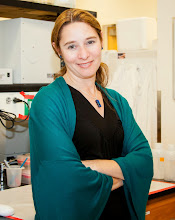I’ve been working out a lot lately (I refuse to believe that I’m getting older) and many of my workouts focus on my “core” muscles (for you non-gym rats, those are your abs). Stronger core muscles help improve our posture, support our back, and look great in a swimsuit. Similarly, a strong core message improves our talk-it gives us a central anchor point. Without a strong core message our facts and experimental details flounder in space, just like our limbs flop around without our core muscles holding them together.
A scientific talk should have a single core message. Not two messages, or three, but a single central point around which all facts, experiments, and data connect. This can be a specific scientific conclusion, like the rate at which a specific glacier is moving, or something more general that stems from your research. NIH’s Jennifer Lippincott-Schwartz works on cutting edge fluorescent imaging techniques, and her core message often focuses on utility of these techniques, rather then a message about a specific intracellular process.
For a shorter talk to a lay audience, the core message might not be rooted in your specific data but rather in the general data of the field. At a recent Seattle Science on Tap session, speaker and Engage Science co-founder Rachel Mitchell rooted a plant biology talk with a core message about the wickedness of invasive plant species. This core allowed Rachel to bring in data from many different subfields in plant biology, yet still connect with the audience.
How do you determine your single core message? I tend to start with the end in mind-what’s the one thing I want my audience to remember? This take-home message then becomes my core. Some people use mind-mapping, which is a technique that allows us to explore branching ideas in a non-linear fashion so that we can compare ideas and hone in on the key ones. The idea at the center of the mind-map becomes the core, because it anchors the other ideas together. Mind-mapping is becoming increasingly popular as a tool to help organize one’s thoughts, and there are several software programs to help those of us that are artistically-challenged draw our map. In fact, I recently attended a talk on time management where the presenter’s visual aids were laid out as a mind-map using one of these software tools.
In Escape from the Ivory Tower, scientist and author Nancy Baron describes the “message box” approach to planning a talk, where the core issue is laid out, surrounded by the important questions that must be answered in a talk about that issue, like “what’s the problem?” and “why should anyone care?”. If these questions aren’t directly related to the core message at the center of the box, cross off that message and try again until you reach the true core.
So what’s your core message? Is it strong enough to build your talk around? Will it help your talk become leaner and more fit? Once we find our single, strong core message, then what do we do? Next post we’ll look at how to build a talk around that core, and how to tell stories in a scientific context.

No comments:
Post a Comment